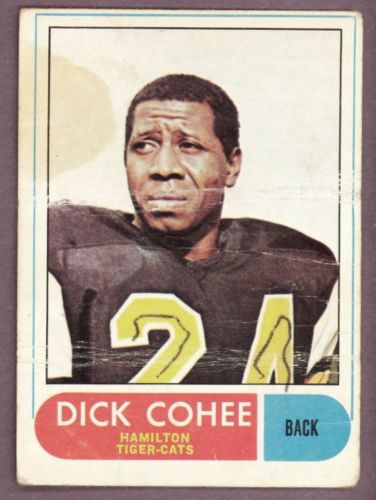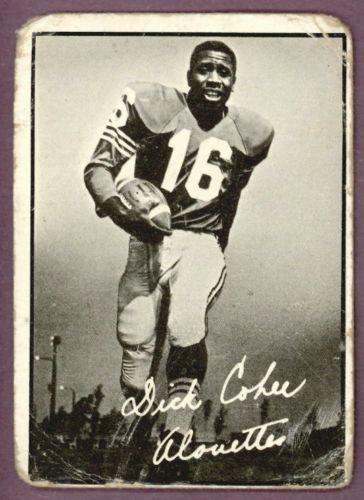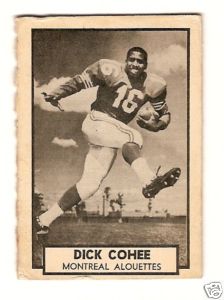Starting out playing for small school Reedley Junior College, in California somehow led Dick Cohee on a successful tour of four CFL teams during his career. Garnering attention at Reedley for scoring 15 touchdowns in his senior year, The Alouettes signed him for a tryout in June, 1960. In his first test he ran for a 91 yard touchdown in an intra-squad ( Red & White) and helped make his case to force his way into a very crowded backfield completion. Unlikely to move all-star George Dixon or vaunted newcomer Don Clark from running back, Cohee adapted and became a candidate as a receiver instead. Injuries early in season gave him an opportunity to help out on the feeble Montreal defensive side in a bid to stay with the team. As a rookie kick returner, he turned heads with a 102 yard effort in one game.
Cohee turned his position flexibility to his advantage in 1961, and continued to play a number of positions as injuries created opportunities to get into the line-up, including a few games replacing Dixon at halfback. However Cohee became a victim of the injury jinx himself, and was not able to play the complete season. In the off-season, Cohee underwent surgery. The 1962 season started out with more uncertainty on the Alouette offence, and it was decided three games into the season, that Cohee would not be part of the answer and he was waived and picked up immediately by Ottawa as a replacement for the injured George Brancato. Used primarily as a defensive back, he was released prior to their first playoff game in November when Brancato returned, and was promptly signed by Saskatchewan for the 1963 season as part of a plan to replace the traded Ferdie Burkett. Once again, however, Cohee found himself playing defense – this time as a linebacker. However by the end of the season, he was back on offence as an end scoring two touchdowns in a semi-final playoff win over Calgary that season. In October, 1964 Cohee suffered two broken ribs and was subsequently traded to Hamilton for tackle Ken Kilrea. In Hamilton he continued to play a mix of defence and offence, and played well enough at halfback, replacing John Counts, that he stayed in the backfield, often playing both ways in a game. By 1965 Hamilton had restricted him to the defensive side of the ball but added kick returning to his duties. In 1966, Cohee returned to the offence where he was the Ti-Cats leading rusher while leading the East in kick returning. Cohee even threw a TD pass on the option play. In 1967 Cohee, described by the Ottawa Citizen, as a “worldbeater runner”, only appeared in 6 games due to a season-ending knee injury on September 17th. Further hampered by a pre-season ankle injury, Cohee's1968 season consisted of a single game. In September before he was placed on waivers after spending six weeks on the injured list and chose to retire to sell cars, raise chinchilla and play golf in the Hamilton area. Cohee was with Hamilton when they won two Grey Cups (1965 and 1967), though injuries kept Cohee out of the 1967 contest.
Dick Cohee passed away on October 11, 2013.
{Bio by Wes Cross]
Dick Cohee in WikipediaDick Cohee on Fanbase
Cohee Runs 91 Yards For TD In Intra-Squad Game - July 12, 1960
Cohee to Appear Against Tiger-Cats - September 10, 1960
Cohee Released By Montreal - August 27, 1962
Cohee Waived By Ottawa - November 7, 1962
Versatile Cohee Joins Roughrider Club - March 21, 1963
Cohee Out With Two Broken Ribs - October 1, 1964
Cohee Put On Waivers By Saskatchewan - October 2, 1964Cohee Retires - Will Play Golf - September 25, 1968
Farewell to Dick Cohee - October 11, 2013
`Curtis, Cohee,two CFL Trendsetters Die
Obituary for Dick Cohee on legacy.com
| Year | Team | GP | PA | PC | % | Yds | TD | Int | Sacked | Yds | TC | Yds | Avg | TD | Rec | Yds | Avg | TD | Long | PTS |
|---|---|---|---|---|---|---|---|---|---|---|---|---|---|---|---|---|---|---|---|---|
| 1960 | MON | 11 | 0 | 0 | 0 | 0 | 0 | 0 | 0 | 0 | 31 | 193 | 6.2 | 0 | 22 | 450 | 20.5 | 1 | 82 | 18 |
| 1961 | MON | 8 | 0 | 0 | 0 | 0 | 0 | 0 | 0 | 0 | 29 | 203 | 7 | 0 | 3 | 25 | 8.3 | 0 | 13 | 0 |
| 1962 | OTT | 5 | 0 | 0 | 0 | 0 | 0 | 0 | 0 | 0 | 0 | 0 | 0 | 0 | 0 | 0 | 0 | 0 | 0 | 6 |
| 1962 | MON | 3 | 0 | 0 | 0 | 0 | 0 | 0 | 0 | 0 | 12 | 73 | 6.1 | 0 | 3 | 12 | 4 | 0 | 5 | 0 |
| 1963 | SASK | 0 | 0 | 0 | 0 | 0 | 0 | 0 | 0 | 0 | 0 | 0 | 0 | 11 | 192 | 17.4 | 2 | 35 | 18 | |
| 1964 | HAM | 4 | 0 | 0 | 0 | 0 | 0 | 0 | 0 | 0 | 0 | 0 | 0 | 0 | 0 | 0 | 0 | 0 | 0 | 0 |
| 1964 | SASK | 8 | 0 | 0 | 0 | 0 | 0 | 0 | 0 | 0 | 8 | 38 | 4.7 | 0 | 7 | 128 | 18.3 | 1 | 44 | 12 |
| 1965 | HAM | 14 | 0 | 0 | 0 | 0 | 0 | 0 | 0 | 0 | 1 | 4 | 4 | 0 | 0 | 0 | 0 | 0 | 0 | 6 |
| 1966 | HAM | 14 | 2 | 1 | 50 | 49 | 1 | 0 | 0 | 0 | 104 | 635 | 6.1 | 2 | 9 | 174 | 19.3 | 0 | 44 | 12 |
| 1967 | HAM | 6 | 0 | 0 | 0 | 0 | 0 | 0 | 0 | 0 | 53 | 238 | 4.5 | 3 | 5 | 98 | 19.6 | 0 | 22 | 18 |
| 1968 | HAM | 1 | 0 | 0 | 0 | 0 | 0 | 0 | 0 | 0 | 3 | 6 | 2 | 0 | 0 | 0 | 0 | 0 | 0 | 0 |
| Year | Team | KOR | Yds | Avg | TD | Long | PR | Yds | Avg | TD | Long |
|---|---|---|---|---|---|---|---|---|---|---|---|
| 1960 | MON | 14 | 390 | 27.9 | 1 | 102 | 1 | 0 | 0 | 0 | 0 |
| 1961 | MON | 5 | 64 | 12.8 | 0 | 22 | 0 | 0 | 0 | 0 | 0 |
| 1962 | OTT | 0 | 0 | 0 | 0 | 0 | 0 | 0 | 0 | 0 | 0 |
| 1962 | MON | 5 | 70 | 14 | 0 | 23 | 0 | 0 | 0 | 0 | 0 |
| 1963 | SASK | 3 | 35 | 11.6 | 0 | 13 | 2 | 3 | 1.5 | 0 | 3 |
| 1964 | HAM | 0 | 0 | 0 | 0 | 0 | 0 | 0 | 0 | 0 | 0 |
| 1964 | SASK | 3 | 131 | 43.6 | 1 | 58 | 1 | 3 | 3 | 0 | 3 |
| 1965 | HAM | 13 | 331 | 25.5 | 0 | 35 | 0 | 0 | 0 | 0 | 0 |
| 1966 | HAM | 14 | 398 | 28.4 | 0 | 52 | 0 | 0 | 0 | 0 | 0 |
| 1967 | HAM | 5 | 143 | 28.6 | 0 | 50 | 0 | 0 | 0 | 0 | 0 |
| 1968 | HAM | 0 | 0 | 0 | 0 | 0 | 0 | 0 | 0 | 0 | 0 |
| Year | Team | Int | Yds | Avg | TDInt | Long | FR | Yds | Avg | TD | Long | FF |
|---|---|---|---|---|---|---|---|---|---|---|---|---|
| 1960 | MON | 1 | 43 | 43 | 1 | 43 | 0 | 0 | 0 | 0 | 0 | |
| 1961 | MON | 0 | 0 | 0 | 0 | 0 | 0 | 0 | 0 | 0 | 0 | |
| 1962 | OTT | 1 | 8 | 8 | 0 | 8 | 0 | 0 | 0 | 0 | 0 | |
| 1962 | MON | 0 | 0 | 0 | 0 | 0 | 0 | 0 | 0 | 0 | 0 | |
| 1963 | SASK | 1 | 0 | 0 | 0 | 0 | 0 | 0 | ||||
| 1964 | HAM | 1 | 4 | 4 | 0 | 4 | 1 | 0 | ||||
| 1964 | SASK | 0 | 0 | 0 | 0 | 0 | 0 | 0 | 0 | 0 | 0 | |
| 1965 | HAM | 3 | 63 | 21 | 1 | 35 | 3 | 0 | ||||
| 1966 | HAM | 0 | 0 | 0 | 0 | 0 | 0 | 0 | 0 | 0 | 0 | |
| 1967 | HAM | 0 | 0 | 0 | 0 | 0 | 0 | 0 | 0 | 0 | 0 | |
| 1968 | HAM | 0 | 0 | 0 | 0 | 0 | 0 | 0 | 0 | 0 | 0 |
| Year | Team | F | FL |
|---|---|---|---|
| 1960 | MON | 0 | |
| 1961 | MON | 0 | |
| 1962 | OTT | 0 | |
| 1962 | MON | 0 | |
| 1963 | SASK | 1 | |
| 1964 | HAM | 0 | |
| 1964 | SASK | 0 | |
| 1965 | HAM | 0 | |
| 1966 | HAM | 2 | |
| 1967 | HAM | 1 | 1 |
| 1968 | HAM | 0 |




